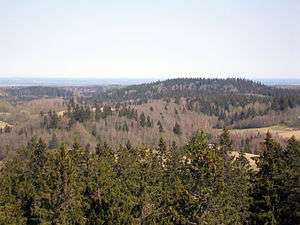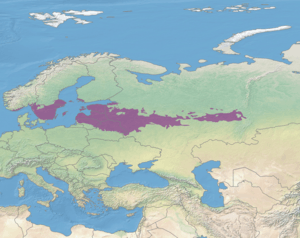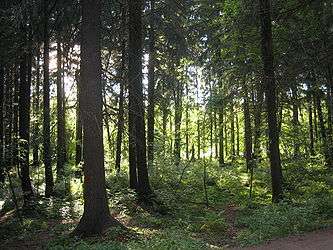Sarmatic mixed forests
The Sarmatic mixed forests constitute an ecoregion within the temperate broadleaf and mixed forests biome, according to the World Wide Fund for Nature classification (ecoregion PA0436).
| Sarmatic mixed forests | |
|---|---|
 Deciduous trees mixed with conifers | |
 Ecoregion PA0436 | |
| Ecology | |
| Realm | Palearctic |
| Biome | temperate broadleaf and mixed forests |
| Borders | |
| Geography | |
| Area | 846,100 km2 (326,700 sq mi) |
| Countries | |
| Coordinates | 56°43′N 27°27′E |
| Conservation | |
| Protected | 84,571 km² (10%)[1] |
Distribution
This ecoregion is situated in Europe between boreal forests/taiga in the north and the broadleaf belt in the south and occupies about 846,100 km² (326,700 mi²) in southernmost Norway, southern Sweden (except southernmost), southwesternmost Finland, northern Lithuania, Latvia, Estonia, northern Belarus and the central part of European Russia.
It is bordered by the ecoregions of Scandinavian and Russian taiga (north), Urals montane tundra and taiga (east), East European forest steppe (southeast), Central European mixed forests (southwest) and Baltic mixed forests (west), as well as by the Baltic Sea.
Description
The ecoregion consists of mixed forests dominated by Quercus robur (which only occasionally occurs farther north), Picea abies (which disappears further south due to insufficient moisture) and Pinus sylvestris (in drier locations). Geobotanically, it is divided between the Central European and Eastern European floristic provinces of the Circumboreal Region of the Holarctic Kingdom.
- Stockholm - Swamp in a sarmatic mixed forest.
 Norway - Winter in the beech forest in Larvik, Norway. Aside from conifers, black alder, white birch and elm are more common in the Sarmatic mixed forest.
Norway - Winter in the beech forest in Larvik, Norway. Aside from conifers, black alder, white birch and elm are more common in the Sarmatic mixed forest.

See also
- List of ecoregions in Europe
External links
| Wikimedia Commons has media related to Sarmatic mixed forests. |